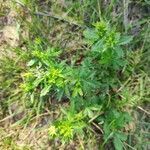Stems ascending to erect, 2–5 dm. Basal leaves palmate or ternate. Cauline leaves 3–8, proximal ones (3–)5–14 cm; proximal petioles (1–)2–10 cm, long hairs sparse to common, spreading to loosely appressed, 1–2 mm, weak, short or crisped hairs sparse to common, cottony hairs absent, glands absent or sparse; leaflets usually 5, central one oblanceolate to obovate, 2–4.5 × 1–2.5 cm, margins ± flat, distal 3/4+ usually unevenly, sometimes evenly, incised 1/3–2/3 to midvein (often with 1–2 incisions nearly to midvein), teeth 5–10 per side, surfaces similar or ± dissimilar, abaxial green to grayish green, long hairs sparse to common (especially on veins), 0.5–1.5 mm, soft to weak, short or crisped hairs ± sparse, cottony hairs absent, glands absent or sparse, adaxial long hairs absent or sparse, 1 mm, short hairs absent or sparse, crisped and cottony hairs absent, glands absent or sparse. Inflorescences 20–100+-flowered. Pedicels 0.5–1.5(–2.5) cm. Flowers: epicalyx bractlets lanceolate to ovate or elliptic, 2–5 × 0.8–1.5 mm, lengths usually 2/3, sometimes 1, times sepals; sepals 3.5–6.5 mm, apex ± acute; petals 3–5 × 2–3 mm; filaments 0.8–2 mm, anthers 0.3–0.5 mm; carpels 40–70, styles 1–1.2 mm, scarcely papillate-swollen proximally. Achenes 1 mm, rugose. 2n = 28, 56 (Eurasia).
More
Perennial from a stout root, erect or decumbent, leafy, 3–7 dm; lvs digitate, the larger with 5 lfls, these oblanceolate to obovate, 3–5 cm, deeply and often irregularly serrate above the entire cuneate base, villous or sericeous beneath, with or more often without a thin tomentum; infl much-branched; fls numerous, 8–10 mm wide; pet yellow, about equaling the sep; stamens 20; cal and bractlets accrescent, to 15–20 mm; achenes wrinkled, with conspicuous longitudinal ridges; 2n=28, 42, 56. Native of Eurasia, found as an occasional weed in dry soil and waste places in our range. June–Sept.






